Ever since I started cooking for myself in my early twenties, I’ve always made my own homemade pesto. In my opinion, homemade pesto sauce is much healthier, tastier, and much fresher than store-bought. It can also be cheaper too. Growing up, my mom also made pesto from scratch often instead of opting for the store-bought version. She showed me how easy it was to make, which influenced my cooking today. Whenever my mom made pesto, she would always use walnuts, naturally making pesto without pine nuts.
Pesto without pine nuts has always been the pesto sauce I’ve grown up eating and continue making. Using walnuts in my pesto sauce without pine nuts gives pesto the most hearty flavor of any nut alternative. I personally favor it over pine nuts themselves!
In this article, I’ll go over how you can make this pesto without pine nuts recipe in 15 minutes or less, and how to use it in a variety of recipes.
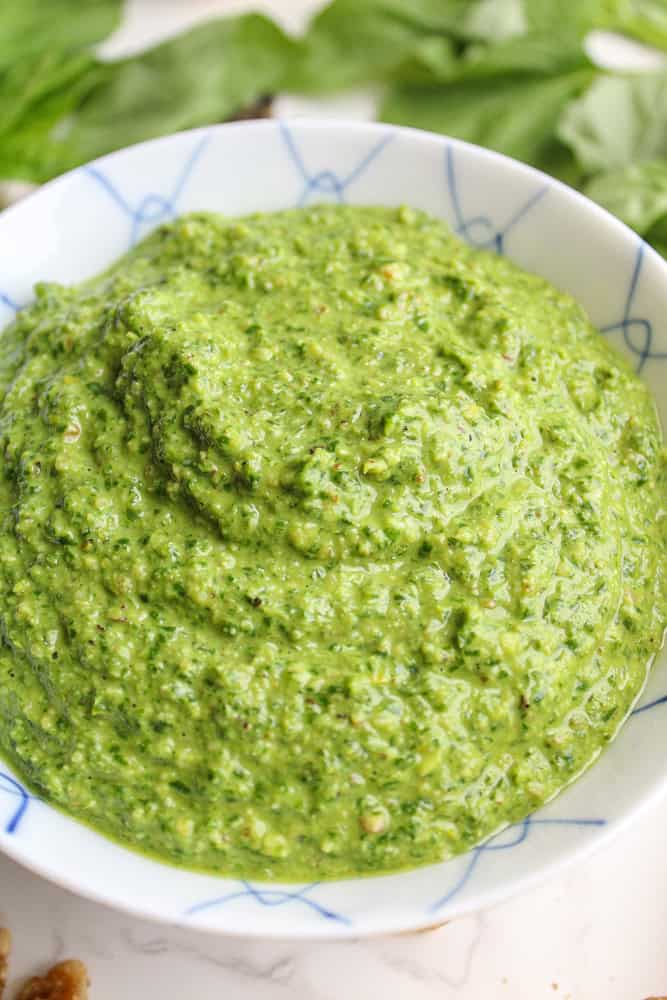
What is Pesto without Pine Nuts
Pesto is a blended basil olive oil sauce that is widely used in Italian cuisine. It’s made up of basil, garlic, pine nuts, extra virgin olive oil, parmesan cheese, salt, pepper, and sometimes lemon. Pesto is widely used as a creamy sauce for pasta. You can mix pesto with heavy cream and sauté it with cooked pasta, vegetables, and your choice of protein.
Creamy pesto sauce without pine nuts is pesto with the pine nuts omitted. Oftentimes, you can replace the pine nuts with other varieties of nuts, or leave them out completely.
Ingredients for Pesto without Pine Nuts
This easy homemade pesto is a very simple recipe that only takes the blending of 8 ingredients.
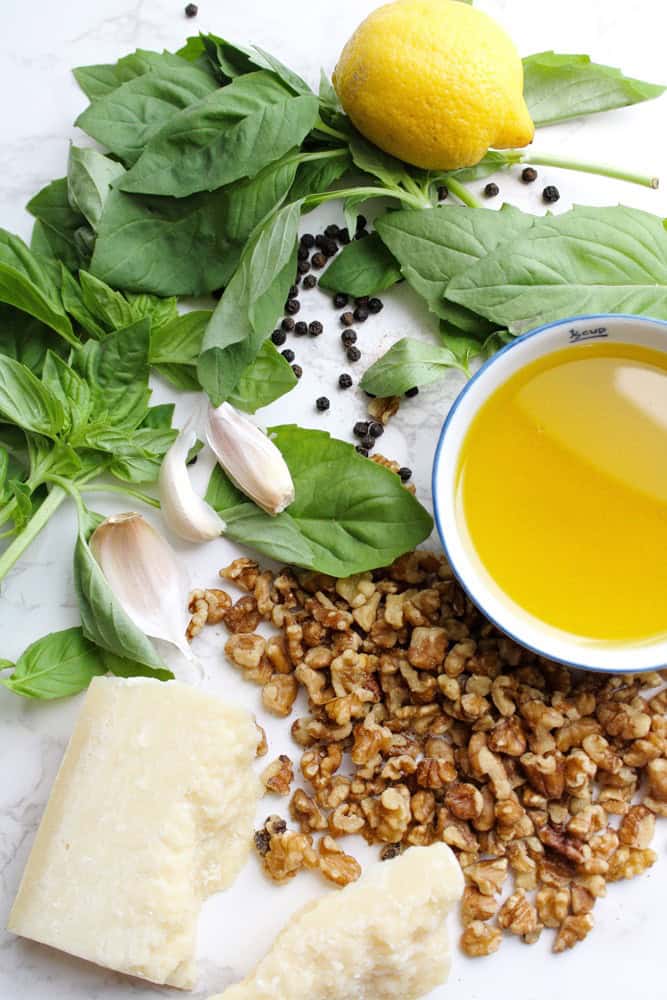
Fresh Basil Leaves: Remove the leaves from the stems to use in the pesto sauce. In this recipe, use four cups fresh basil.
Extra Virgin Olive Oil: Only source the best quality olive oil for this pesto recipe. For recipes that don’t require high heat or a lot of cooking, use cold-press extra virgin olive oil. This is the highest-grade olive oil. When the olives are crushed and pressed for oil, the extra virgin oil will be the olive oil from that first press only. EVOO has a much darker color, retains a fuller flavor profile, and has many more nutrients than other olive oil types.
You can buy extra virgin olive oil in any local grocery store. Just go to the oils aisle, and look for bottles of olive oil that say “cold press” and “extra virgin”. In this recipe, use ½ cup extra virgin olive oil.
Freshly Grated Parmesan Cheese: This pesto sauce recipe without pine nuts calls for ¼ cup parmesan cheese. In order to make the best pesto recipe without pine nuts, used aged parmesan. Most parmesan you’ll find in the stores are between 18 to 36 months old. I recommend using parmesan over three years old if you can find it.
Older parmesan will be crumblier and grainier in texture and feel. This will only become more pronounced as it gets older. It will develop a nuttier flavor, too.
Garlic: It wouldn’t be pesto without garlic. This recipe calls for three cloves of garlic. Garlic will add a pungent, spicy flavor to the sauce. You can increase the amount of garlic for increased spiciness, or decrease it for a milder pesto without pine nuts.
Walnuts: Walnuts are my main substitute for pesto without pine nuts. I prefer using walnuts over other nut varieties because it makes the pesto taste heartier and more savory.
Plus, it’s one of the cheapest nuts you can use, and it’s full of plant-based omega-3 fatty acids!
Lemon: Traditional pesto doesn’t have lemon, but adding it truly makes it taste better in my opinion. My mom made it this way when I was growing up, and taught me to make it this way, too. In this recipe, add the zest and juice of one lemon.
It will add a pop of freshness to the flavor profile, and add a subtle hint of tart that will balance out the spiciness of the garlic and the salty cream of the parmesan.
Salt and Pepper: You can’t have delicious food without salt and pepper. For this recipe, use ½ teaspoon of both salt and freshly ground black pepper.
Equipment Needed for Pesto without Pine Nuts
Food Processor: The food processor will be one of the most important pieces of equipment for this recipe. Use it to blend all of the ingredients together into a fine paste.
If you don’t have a food processor, use a mortar and pestle.
Cutting Board: You’ll need a cutting board to chop the walnuts and garlic. You can use any kind of cutting board, big or small.
Chef’s Knife: I like using a quality chef’s knife, but you can use any knife you have on hand. If you’re really strapped for equipment, you can use a steak knife, or even forgo the knife.
All of the ingredients, including the walnuts, parmesan, and garlic, you can add to the food processor whole. However, chopping these ingredients can help you blend them more smoothly. For parmesan, just break it up with your hands into small pieces before throwing them in the food processor.
Colander: Use a colander to wash the basil. Washing your basil (and washing your fruits and vegetables in general), will ensure you are washing away dirt and bugs that might get into the food. Especially if you’re eating food that will be eaten raw, it’s important to use a colander to wash your food thoroughly.
If you don’t have a colander, then hold a bunch of basil in your hand, and run under the faucet for a few good seconds.
Micro-Plane Grater: Use a micro-plane grater to zest your lemon and grate the parmesan. A micro-plane grater has finer blades, which allows you to shave food more finely and consistently than a regular box grater.
However, if you don’t have a micro-plane grater, just use a regular grater.
Lemon Squeezer: Use a lemon squeezer to extract the juice from one lemon to use in this pesto recipe without pine nuts. A lemon squeezer will help you extract every last ounce of juice from the citrus fruit while catching all of the seeds.
If you don’t have a lemon squeezer, then cut a lemon in half, and squeeze the lemon half into your hand over a bowl, allowing the juice to spill through your fingers while your hands catch the seeds.
Rubber Spatula: A rubber spatula will help you scrape the bowl of the food processor, so you get every last ounce of pesto you’ve made.
How to Make Pesto without Pine Nuts
Chop and Prep Your Ingredients:
- Roughly chop the garlic cloves and walnuts, and set aside.
- Grate the parmesan.
- Separate the leaves from the stems, wash the basil leaves, and set aside.
- Zest and juice the lemon.
Combine the Ingredients in a Food Processor: Combine the basil, garlic, lemon zest and juice, parmesan, walnuts, extra virgin olive oil, salt, and pepper in a food processor.
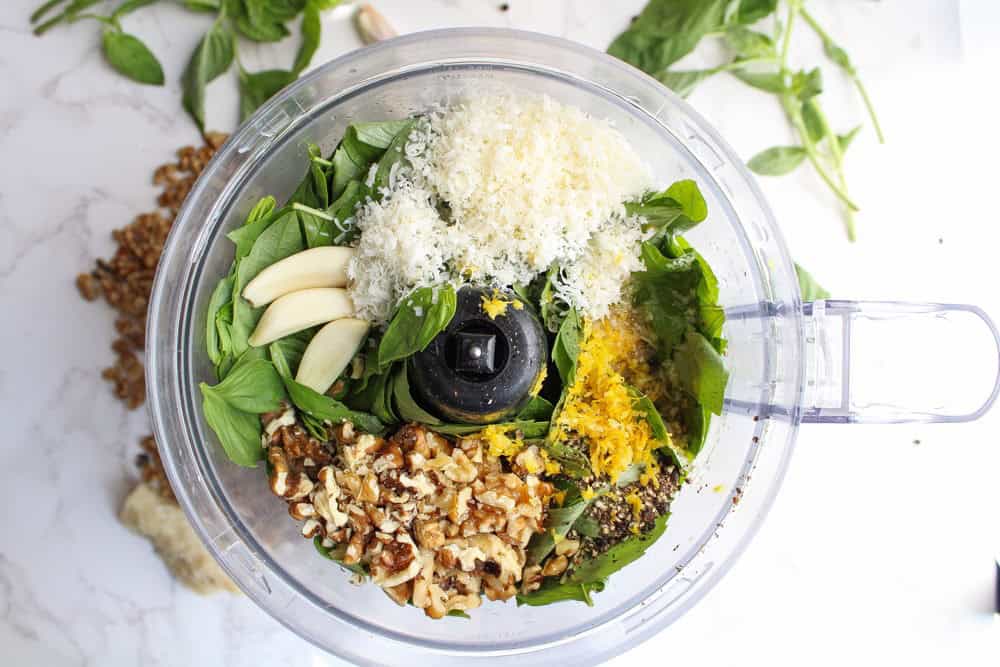
Pulse Until Smooth: Blend the ingredients until they are smooth. You may need to use your spatula, scrape down the sides of the bowl, and blend again. This way, all of the ingredients blend smoothly together.
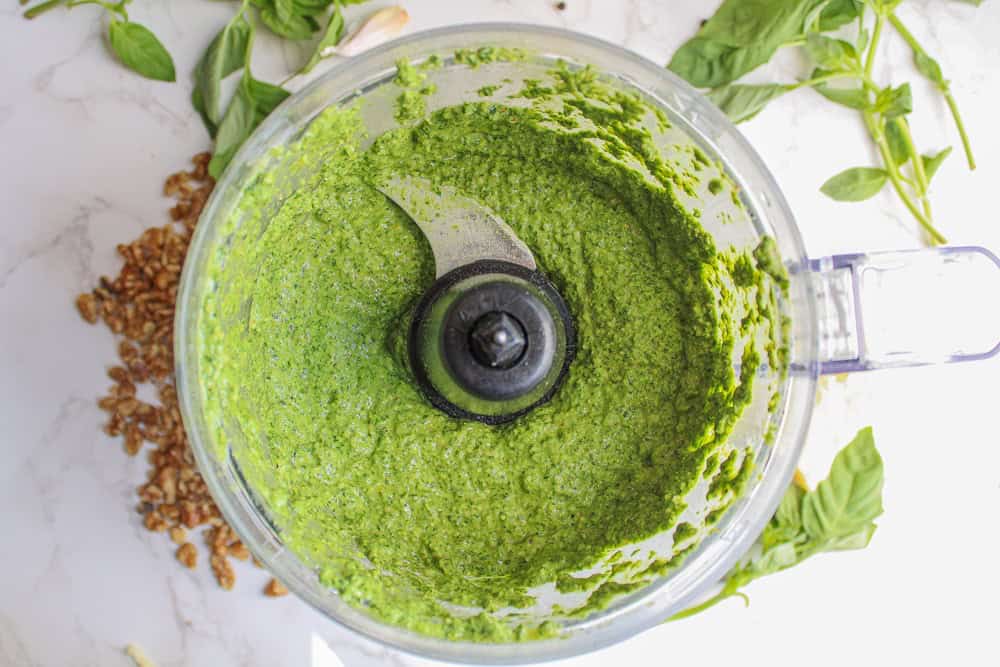
Taste Test and Adjust as Needed: Once the pesto is blended, taste it and adjust the flavoring as needed. Add more salt or pepper, grate some more parmesan, or squeeze more lemon juice according to your preferences.
Serve or Store: Scrape the pesto out of the food processor bowl with a spatula, and use it right away in your favorite recipes. You can also store it in an air-tight container to use for later.
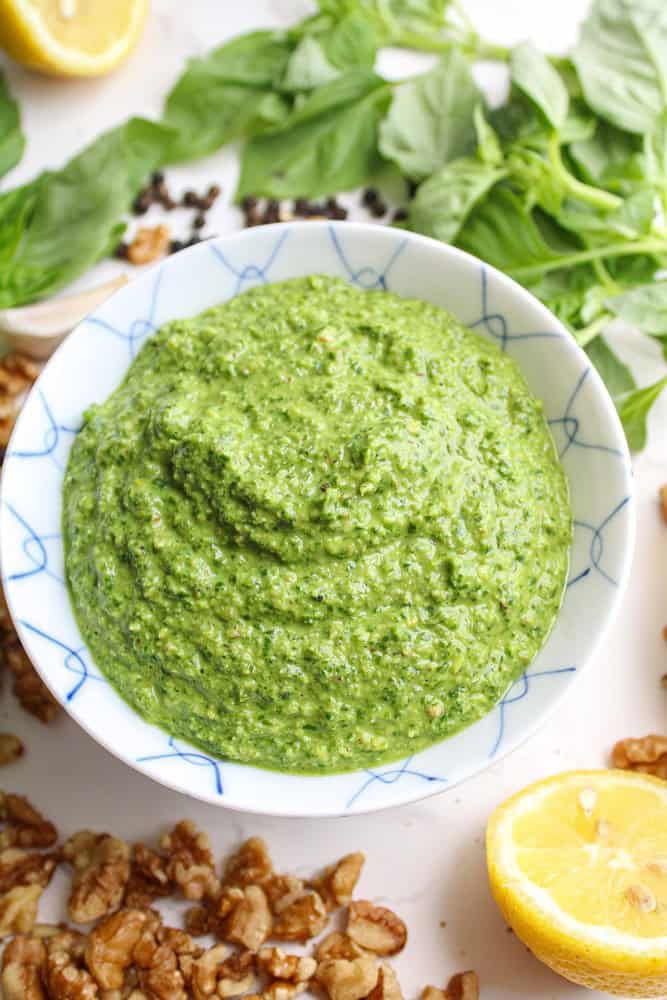
Tips for Making the Best Pesto without Pine Nuts
- Chop the ingredients before you blend them in the food processor. This will help you achieve a smoother consistency.
- Use extra virgin olive oil for extra flavor depth and increased nutritional benefits.
- Use aged parmesan of greater than three years to add a nuttier flavor to your pesto without pine nuts.
- Try to use or serve your homemade pesto without pine nuts right after you make it. If you store it and wait to use it a couple of days later, it will turn browner. This won’t look as good, nor will it be as fresh.
- If you’re storing the pesto to use at a later date, then store it in an air-tight container. Either squeeze a layer of lemon juice on top or drizzle a layer of olive oil on top to preserve its freshness.
- Use a spatula to scrape the bowl of the food processor. This will ensure you get every last bit of pesto you make. A lot of the pesto can easily stick to the sides of the bowl, producing a lot of waste if you don’t use the right tools.
- Add at least one cup or more of spinach, arugula, parsley, or other herbs and greens along with the basil. This will not only enhance the nutritional benefits of this pesto recipe but possibly add extra flavor!
- Use the highest quality ingredients! If you like gardening, I recommend growing your own basil.
Substitutions for Pesto without Pine Nuts
Basil: Try to have basil on hand, as this is the main ingredient. It’s what makes pesto, pesto! But if you don’t have enough, or you didn’t plan well, you can use a variety of greens and herbs. I like using a mixture of spinach, arugula, fresh oregano, cilantro, and parsley. By using all of these herbs together, it creates a dynamic flavor profile.
If you don’t have the luxury of using a variety of greens and herbs, you can use one variety from the list above.
Extra Virgin Olive Oil: You can use regular olive oil or grapeseed oil. If you’re really in a pinch, canola oil and sunflower oil are good alternatives.
Parmesan: If you don’t have parmesan cheese available to you, my #1 substitute would be pecorino cheese. This cheese is very popular in authentic Italian cuisine and beholds the same creamy and nutty flavors.
Other substitutes you can use include Gruyere and Manchego. If you want to make your pesto vegan, then sweet white miso is a great substitute.
Garlic: Substitute garlic for granulated garlic or garlic powder. Since this recipe calls for three cloves of garlic, then substitute at least 1 teaspoon of garlic powder. You can also substitute garlic with shallots or chives.
Lemon: You can substitute vinegar for lemon juice. I would recommend using white wine vinegar, red wine vinegar, or apple cider vinegar. You can also omit the lemon juice and zest altogether, as traditional pesto recipes don’t ask for lemon.
Walnuts: If you don’t have walnuts on hand, but you still want to make pesto without pine nuts, then other popular nuts to use in pesto are pistachios and almonds. You can even use seeds such as sunflower seeds, pumpkin seeds, and sesame seeds. You can even omit the nuts altogether for a nut-less pesto. Just note, that if you change the nut you use, it may slightly change the flavor.
Variations for Pesto without Pine Nuts
Herb Pesto: Spice up traditional pesto by adding other herbs and greens with basil. Add fresh oregano, parsley, cilantro, fresh thyme, fresh tarragon, and mint for a widely flavorful pesto. Keep the rest of the ingredients the same, and use the same method of preparation.
This is perfect if you have your own herb garden and need a way to use up all the herbs growing in your backyard.
Oregano Pesto: Replace the basil in this recipe with 2-4 cups of fresh oregano leaves. Using oregano will give your pesto a spicy and pungent flavor.
Hazelnut Pesto: Replace the walnuts in your pesto recipe with hazelnuts instead. Hazelnut pesto will make a slightly sweeter pesto sauce. Just remember to add a little more olive oil, as using hazelnuts can give your pesto sauce a thicker consistency.
Thai Basil Pesto: Replace the regular basil in this recipe with Thai basil, for Thai basil pesto. This type of pesto will taste slightly like star anise or licorice. I recommend swapping the extra virgin olive oil for a blander oil, like canola or grapeseed oil so that the flavor of the Thai basil can stand out.
Roasted Garlic Pesto: Instead of adding 3 raw cloves of garlic, roast a whole head of garlic to put in this pesto recipe instead. Roasted garlic will be much sweeter, creamier, and milder in flavor. It will be less spicy and pungent than raw garlic.
If you want to learn how to roast garlic, follow my recipe on how to roast garlic in the oven.
Garlic Mustard Pesto: Garlic mustard is neither garlic nor mustard. It’s a type of plant grown in the United States. It’s a part of the mustard family and tastes like garlic when the leaves are crushed. In many parts of the country, it’s seen as a weed. You may see it overgrown in your backyard, which will make for a perfect opportunity to make garlic mustard pesto!
Rosemary Pesto: Replace basil with 1-3 cups of fresh rosemary leaves. If you’re using less rosemary (around 1 cup), then increase the amount of cheese you’re using to ½ cup. Rosemary will make for a completely different-tasting pesto, full of earthy and peppery flavors.
Allergy Considerations
Although pesto is a great and versatile sauce to make for a variety of dishes, you may have to adjust it if you have certain allergies.
For those with nut allergies, you can omit the nuts altogether. If you omit the nuts, increase the amount of cheese you use to ½ cup.
If you adhere to a dairy-free diet, replace the parmesan cheese with a vegan replacement, such as nutritional yeast or a vegan parmesan. You can also omit the cheese entirely or use capers or sun-dried tomatoes. This would also make this pesto recipe completely vegan.
This pesto recipe is gluten-free naturally, so you don’t have to make any substitutions to make this pesto without pine nuts.

How to Store Pesto without Pine Nuts
Store your freshly homemade pesto in an air-tight container, and store it in the back of the fridge for 4-5 days. I recommend drizzling one layer of olive oil or lemon juice over the top of the pesto in order to preserve its freshness and color.
You can also freeze pesto in ice cube trays. Once they’re frozen, you can keep them in the ice cube tray until you need to use them, or take them all out and store them in a Ziploc bag in the freezer.
This is a great way to preserve the life of your pesto and prevent food waste.
How to Meal Prep Pesto without Pine Nuts
If you want to meal prep this pesto sauce without pine nuts, double or triple this recipe. This will make 2-3 cups of pesto instead of one.
If you plan to use all of it right away or within the week, you can store it in the fridge as described in the previous section. However, if you’re not, I recommend freezing it. You can put the pesto sauce in ice cube trays, and freeze them until you’re ready to use it.
How to Use Pesto without Pine Nuts
You can use pesto in a variety of ways. You can use it in soups, salads, and sandwiches. You can make a creamy pesto pasta dish with it too. See below for how to use this pesto recipe without pine nuts.
Create a sauce for pasta: Put ½ cup of pesto into a frying pan, and heat to medium-high. Stir it around until it starts to sizzle. Add ⅓ cup of pasta water, ¼ cup heavy cream or half & half, and some grated parmesan. Pour in freshly cooked pasta, and add your favorite veggies to make creamy pesto pasta. Also, try this tuna pesto pasta.
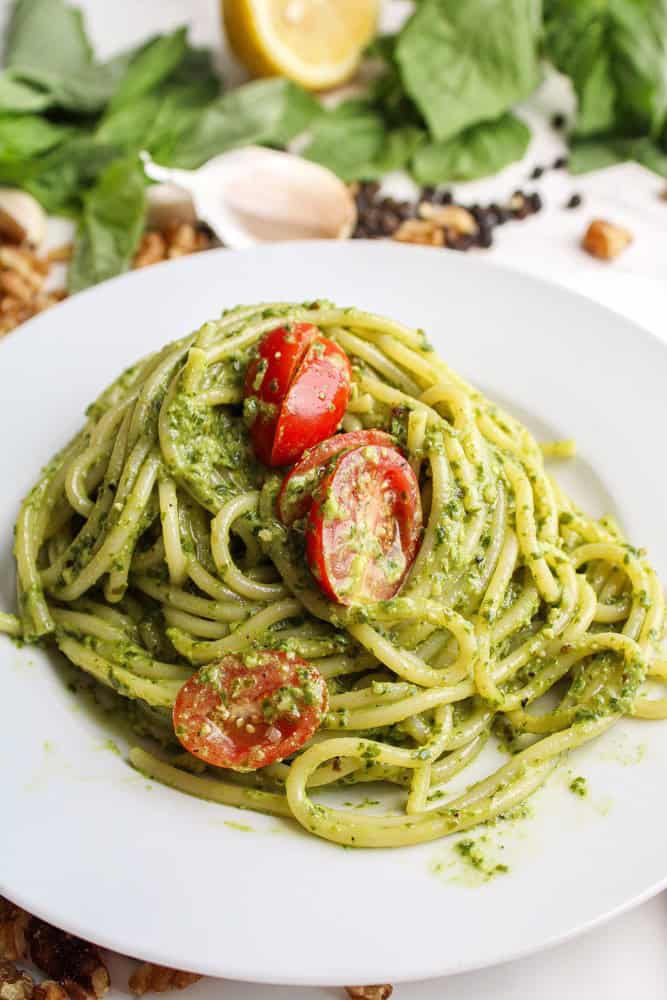
Use as a spread for sandwiches: Use pesto without pine nuts as a spread on sandwiches for an Italian-style lunch. Spread pesto on one side of the bread, and hummus on the other, fill it with turkey, tomato, arugula, and salami. Try this pesto tofu sandwich or chicken pesto sandwich!
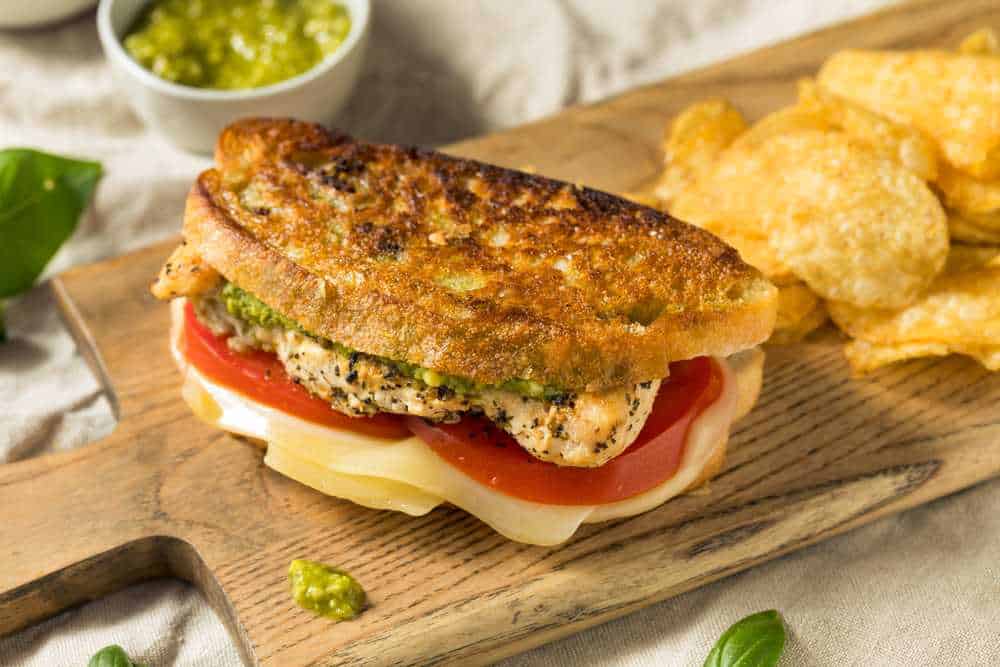
Pair with a salad dressing for salads: I love putting a tablespoon of fresh pesto into my salads. I often make a salad with spring mix and romaine, pour in my Italian style or balsamic dressing, add one tablespoon of pesto, and mix the salad. This can add a burst of flavor to any salad. Other pesto-themed salads you can make include this cucumber avocado tomato salad.
Use as a dip: Dip raw veggies into pesto, such as carrot sticks, snap peas, sliced bell peppers, broccoli, and more. Make dips like this layered pesto appetizer dip or basil pesto hummus.
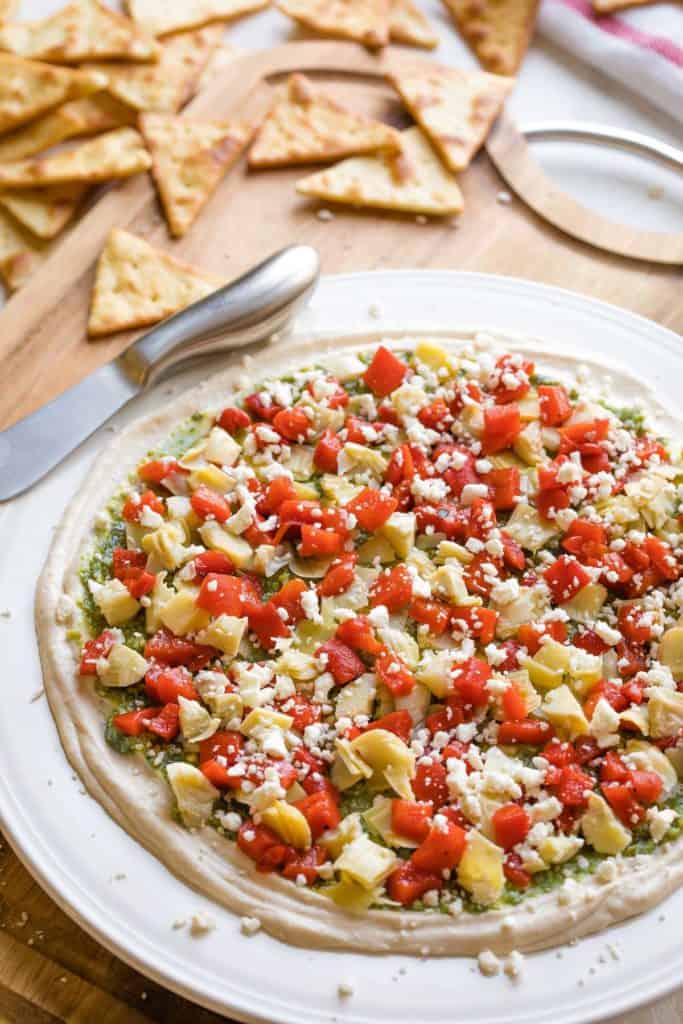
Put it in bakes and casseroles: Make baked keto pesto chicken or easy baked flounder with pesto on top. Make pesto lasagna, baked pesto mozzarella chicken, or creamy pesto tortellini bake with mozzarella.
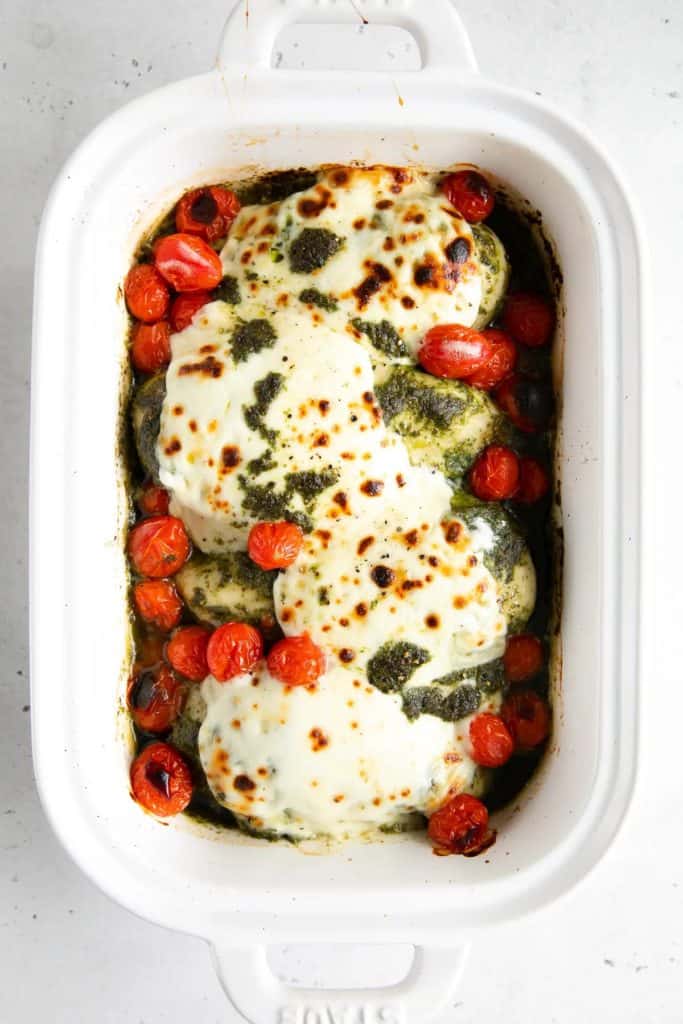
Make homemade pesto rolls: Spread pesto and parmesan cheese over raw dough, roll it into rolls, and bake for a fluffy, savory snack or treat. You can also try this parmesan pesto challah bread.
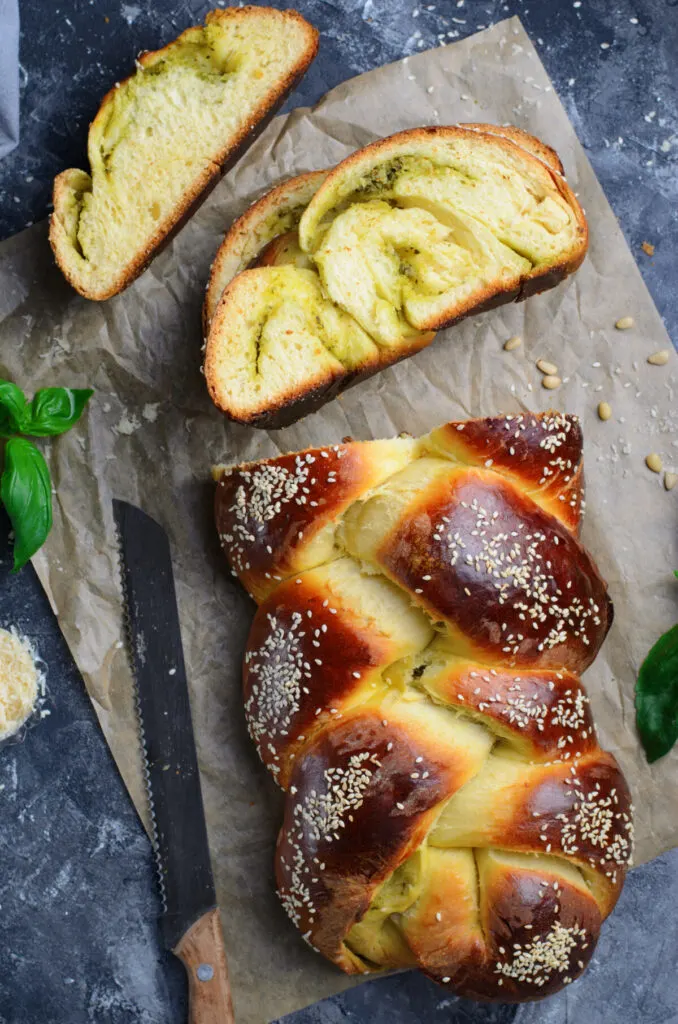
Use in pasta salads: Make cold pasta salads for meal prep and lunches. Try gluten-free pesto pasta salad with tomatoes and asparagus or orzo pesto pasta salad. If you want to spice it up and add some variety, give red pesto pasta a try!
Spread on crostini: Crostini is an easy, quick but fun and delicious way to use pesto without pine nuts! You can get really creative and make crostini like this roasted tomato and pesto crostini with balsamic glaze drizzle.

Pair with vegetable side dishes: Roast your favorite vegetables and drizzle fresh pesto on top. You can also sauté pesto and vegetables for a pesto veggie sauté. Make easy pesto-roasted potatoes or pesto quinoa stuffed tomatoes.

Drizzle pesto over soups: Drizzle a teaspoon of fresh pesto without pine nuts over this freshly roasted tomato soup, vegetable orzo soup, or roasted green tomato soup.
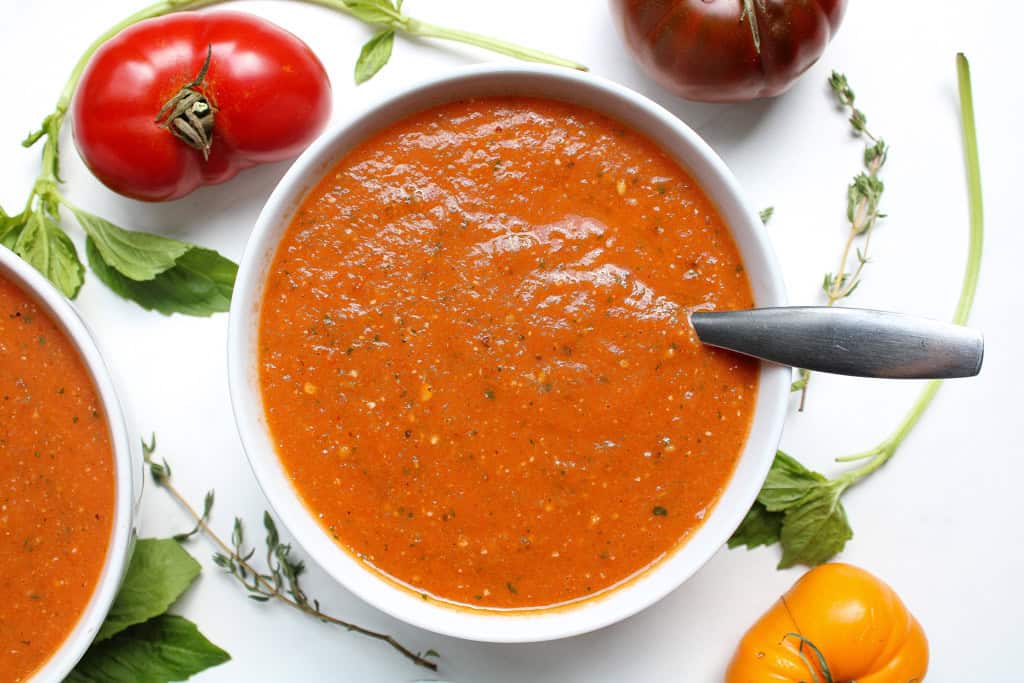
Pesto Pizza: Replace pizza sauce with pesto and make vegan pesto pizza or portobello mushroom pizzas. You can also drizzle it on top of a marinara-based pizza.
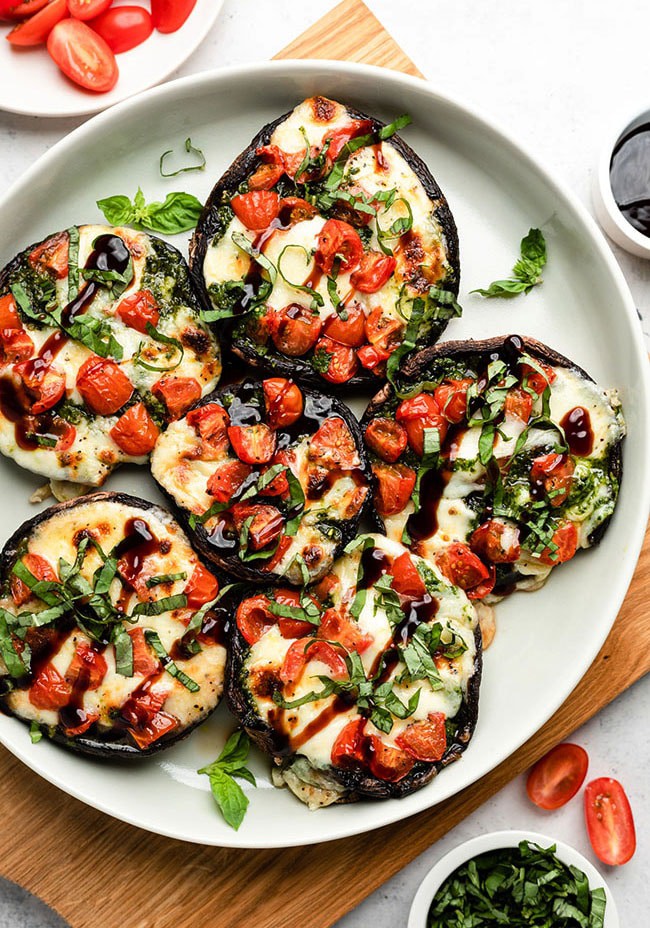
Recipes with Pesto
- Quick & Creamy Ricotta Pesto Pasta
- Tuna Pesto Pasta with Fried Capers
- Courgetti Pesto Caprese Salad
- Veggie Pesto Pasta with Zucchini and Asparagus
- Pesto Chicken Quinoa Bowls
- Pesto Crusted Salmon
- Shrimp Pesto Pasta
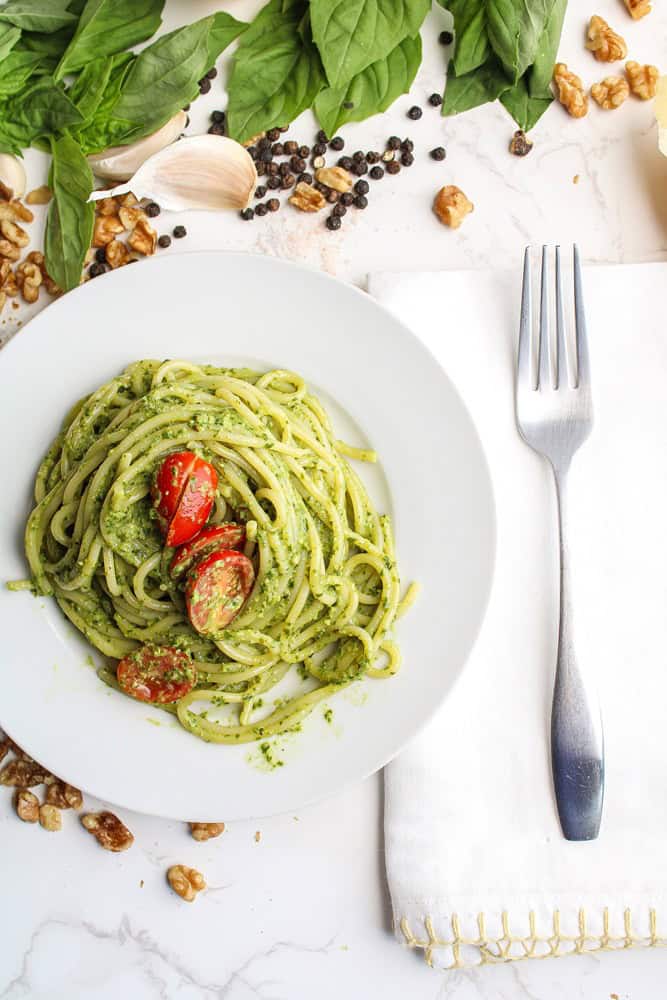
Frequently-Asked Questions
Pesto is a paste or thick sauce made from ground basil leaves, fresh garlic, grated parmesan, pine nuts, and extra virgin olive oil. It originates from Italian and Mediterranean cuisine and is often used in a variety of pasta dishes.
Pesto is delicious without pine nuts! Whether you make pesto without pine nuts by omitting nuts altogether or by using an alternative, will surely depend on your personal taste preferences.
Not necessarily. If you want to make traditional, classic pesto, then the recipe will require pine nuts. However, pesto is very versatile. You can modify it however you want.
Even if you omit pine nuts, your pesto will largely taste the same, especially if you add a nut alternative.
Pine nuts are important for pesto. However, what’s more important? Is using nuts period, whether they’re pine nuts or an alternative.
Nuts add a nutty, aromatic, and sometimes creamy taste and texture when blended. By not adding nuts, the pesto will be much lighter and not taste as hearty. Nuts add a lot of umami flavor.
Absolutely! You can either omit the nuts altogether or use a pine nut alternative, like walnuts, cashews, or almonds. The replacement ratio is 1:1. If your recipe calls for ⅓ cup of pine nuts, you can replace them with a ⅓ cup of the alternative.
Yes! Just substitute the same amount of nuts the recipe calls for but with your alternative. Substitutes you can use are nuts and seeds, including almonds, hazelnuts, walnuts, cashews, sunflower seeds, and pumpkin seeds.
Yes! Just use a different alternative, like almonds, cashews, or hazelnuts.
Follow the recipe below, but instead of using four packed cups of basil, use three cups of basil and one packed cup of raw baby spinach.
Diforti has a nut free pesto. You can buy it online or at your local grocery store. Other popular brands include Stamina Superfoods (which can be bought on Amazon), Cucina and Amore, and Wally’s.
You can make pesto vegan by either omitting the parmesan cheese or replacing it with a vegan alternative, such as vegan parmesan or nutritional yeast.
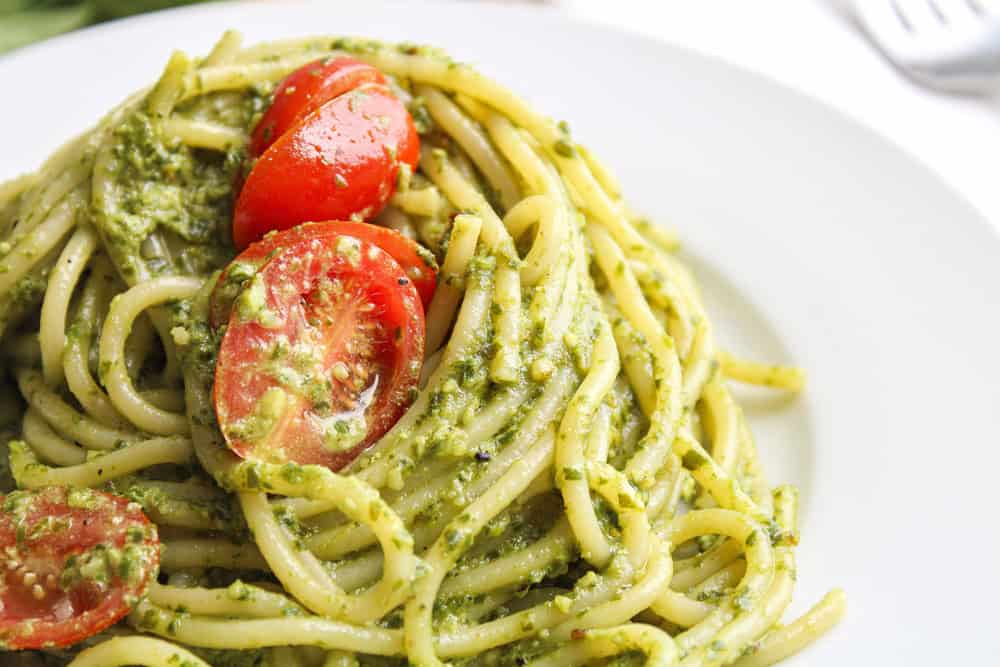
More Sauce & Spread Recipes
More Italian-Style Recipes
- Creamy Sausage Asparagus Pasta
- Strawberry Salad with Lemon and Basil
- Homemade Meatballs and Spaghetti
- Tuna Pesto Pasta with Fried Capers
- Quick & Creamy Ricotta Pesto Pasta

Pesto without Pine Nuts (Quick & Easy)
Equipment
- 1 Food processor
- 1 Cutting board
- 1 Chef's knife
- 1 Colander
- 1 Micro-plane grater or regular grater
- 1 lemon squeezer optional
Ingredients
- 4 cups fresh basil leaves packed
- 3 cloves garlic roughly chopped
- Zest of 1 lemon
- 3 tbsp. lemon juice or juice of 1 lemon
- ¼ cup parmesan grated
- ½ cup walnuts roughly chopped
- ½ cup extra virgin olive oil
- ½ tsp. salt
- ½ tsp. ground black pepper
Instructions
- Start making the pesto by separating the basil leaves from the stems. Discard the stems. Wash and dry the leaves.
- Put the basil, garlic cloves, lemon juice, parmesan, walnuts, salt, and pepper into a food processor and blend together. Using a rubber spatula, scrape down the sides. Slowly add the olive oil through the feed tube of the food processor. Or you can stop the food processor, remove the lid, and drizzle in the olive oil.
- Blend until smooth.
- Store the pesto in the fridge. Pour it into a container and cover it with a layer of olive oil on top to help it last longer.
Nutrition Facts
These values were taken from a nutrition calculator.

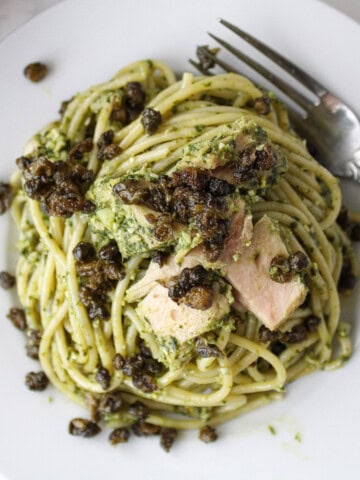
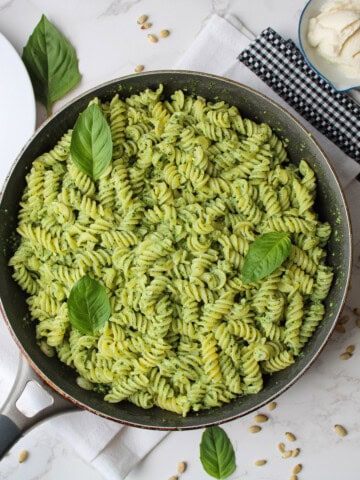
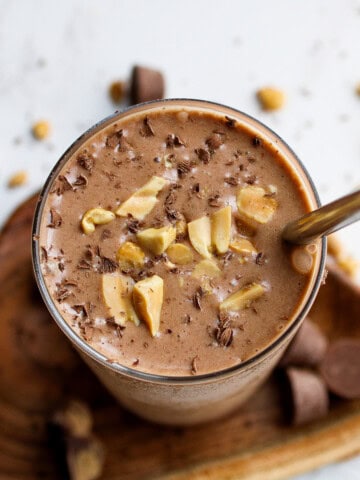
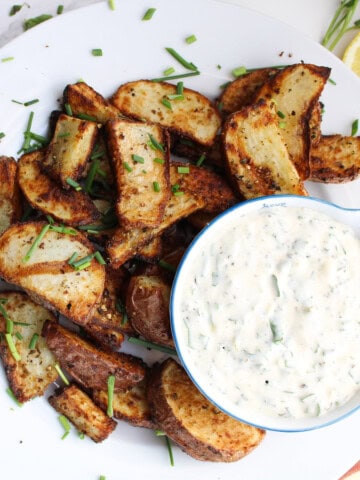
Corinne
Yay! I'm so glad to find someone else who just plain doesn't like pine nuts!
Audrey Sommer
Yes! But with the right substitutions, you can make a delicious pesto! 🙂
Kirtika saha
Thanks for your valuable knowledge information because of useful updated for me, thank you for share this wonderful article.
Audrey Sommer
Of course, thank you!